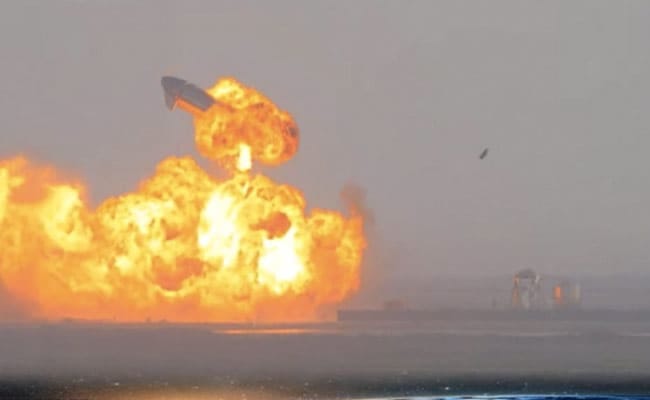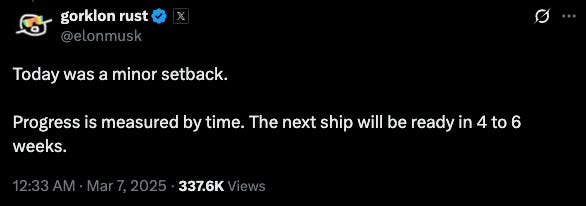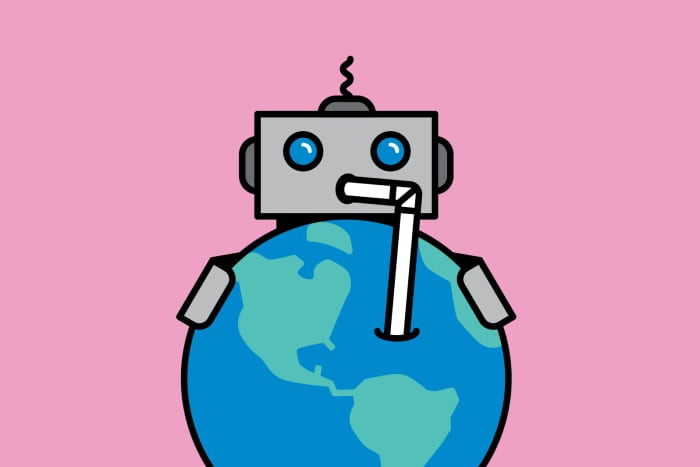Launchpad to Nowhere: The Mars Mirage
Space won’t save us. Musk and Bezos don’t plan to. The real science fiction? Billionaires caring.
Hey, Slick!
You know you’re in good hands when the richest men alive argue over how best to help humanity.
And we’re in luck! Earlier this month, Bill Gates (formerly the richest man in the world, now only #13) criticized his successor Elon Musk for slashing USAID funding and “killing a million children.”
Musk’s response? “Gates is a huge liar”. And his rockets? Supposedly more life-saving than Gates’ toilets. Because in his world, a Martian future matters more than dying children.
Well, Slick—I’ve got good news, and bad news.
The bad news? We’re not going to Mars.
The good news? We’re not going to Mars!
Not anytime soon, anyway.
And that’s lucky, because Mars is a terrible place.
I. We’re Not Going to Mars
Let’s start with the obvious: Mars is a terrible place to live.
This Place Sucks…
There’s no air you can breathe, no liquid water on the surface. The soil is toxic. The radiation would fry your insides and cook your DNA. The temperatures routinely drop below –100°C (-150°F). And the sky? A lovely, soul-crushing butterscotch colour, permanently dusty.
It’s not just red: it’s dead.
And no, the sunsets don’t make up for it.
In comparison, Antarctica has air, water, and gravity—and you don’t need a rocket to get there. It’s harsh, but not hostile. And yet no one’s pitching a million-person city there. So why are we pitching one on Mars?
And yet we’re told this is the future of civilization.
Getting to Mars: Physics on Hopium
NASA’s timeline for a cautious, crewed Mars flyby is somewhere around the late 2030s. Maybe. If Artemis stays funded, if everything goes right. They talk in decades, not launch windows. They acknowledge the complexity and the cost; they confront the challenge—and they deal in physics, not miracles.
Musk, by contrast, has said he’ll send a crew to Mars by 2024. No, 2026. Actually, 2029 (sorry Slick, it’s hard to keep track of the timeline revisions).
And have a self-sustaining, million-person colony on the red planet by 2050.
But there’s a problem: we haven’t even sent humans beyond low Earth orbit since 1972. Starship hasn’t made it to Mars orbit, let alone back; its most successful flight so far barely reached space before it exploded like all the other ones.
Every few years, the date slips—but the certainty never does. Even though multiple independent studies—from Nature to MIT and others—have concluded that Musk’s scenario is not just improbable, it’s logistically impossible using any currently available or near-future tech. His mission profiles don’t add up: power sources aren’t there, mass estimates are off by orders of magnitude.
The gap between NASA and Musk isn’t just one of optimism—it’s one of credibility. NASA builds redundancy, Musk builds myth.
But forget the calendar for a second, Slick. Even if we gave him the time, the tools and the tech don’t exist—not yet, not close.
Living on Mars: Science Fiction, Minus the Science
SpaceX’s “plan” relies on a few mission-critical systems we don’t have.
First, colonists will need to use Martian resources to make fuel, air, and water. That’s ISRU (In-Situ Resource Utilization). Sounds great; hasn’t been done. The only real test so far is the MOXIE experiment on Perseverance, which produced a few grams of oxygen from Martian CO₂. A lab test—not a lifeline.
Then there’s power. NASA’s Kilopower reactors—tiny nuclear fission systems—are still in early development, and we don’t know how they’ll perform in Martian dust or cold.
What about life support? No long-duration, Mars-like, closed-loop system has ever kept even a small crew alive for years without resupply. We have no working model of even a ten-person system surviving in Mars-like conditions for more than a few months.
The best experiment we have, Biosphere 2, ended prematurely due to oxygen imbalances and interpersonal breakdown. And that was on Earth—with gravity, accessible materials, and the ability to open a door if things went wrong1.
SpaceX is proposing we do it on Mars, 55 million kilometers away, in lethal conditions—and scale it up by a factor of 100,000.
Radiation shielding? There’s no proven, scalable way to protect settlers from cosmic rays or solar storms—especially for an entire city.
And return vehicles? Not a huge survival concern if you’re not coming back, but worth noting: we’ve never launched a rocket from another planet; Musk says we’ll do it regularly.

The Scale Problem
Let’s assume we start with a pilot base of just four people. Best-case scenario, you’d need over 1,000 tonnes of equipment shipped: a pressurized, radiation-shielded habitat; food or hydroponic farms; oxygen production and water recycling systems; medical and backup life support; power generation (solar and nuclear); and an ascent vehicle—unless we leave them there forever.
Now imagine doing that a quarter million times to build a city of one million. You’d need tens of millions of tonnes of infrastructure, thousands of launches per year for decades, square kilometres of farming in artificial greenhouses, 100–1,000 GW of power generation (enough to run a medium-sized country) and a logistics and fuel pipeline that runs flawlessly for 20+ years.
And that’s if everything works perfectly. There’s no margin for failure; a glitch in water recycling, and the crew dies. A software bug in oxygen balancing, and it’s Game Over.
II. The Myth, Better Than the Math
The tools don’t exist. The logistics don’t check out.
So why does the dream live on?
Because it was never really about survival. It was about salvation. Musk doesn’t just want to build rockets—he wants to build a legacy.
The Elon Prophecy
The Mars project isn’t a mission, it’s a story. One his father, Errol Musk, helped script when he read him Wernher von Braun’s Project Mars, a 1952 sci-fi novel written by a former Nazi scientist. The official title of the future leader of the Martian colony?
"The Elon."
Can’t make this up, Slick… unlike critical SpaceX assumptions.
The myth writes itself. The bullied boy, the “softie,” as his father and classmates used to call him, becomes planetary saviour. A child of prophecy. A man of destiny.
That’s not foresight, but mythology—and Musk is determined to live it. Even if it’s never going to work, even if it’s built on empty promises and drags us further from real solutions: it feels good to play saviour.
The Myth of Competence
The myth of competence has replaced actual engineering. Elon speaks in timelines and certainty; always slipping, never doubting. A million-person, self-sustaining city by 2050 is just the latest headline.
There’s no working prototype, no functioning system, no plan that survives engineering scrutiny; just raw belief and vibes. Starship, the rocket meant to make it all possible, has never completed a clean mission.
But no matter how many times it explodes, the myth survives the blast. The show must go on. Every failure is just a “learning experience,” every explosion is progress.
This isn’t new. Musk’s track record is a graveyard of broken promises: fully self-driving cars by 2016, robotaxis by 2020, and the Optimus humanoid robot… unveiled as a man in a suit doing a dance.
That might work as an investor stunt. But when the same hype fuels a survival plan for humanity, it’s not just unserious—it’s reckless.
The Morality Shell Game
But colonizing Mars and space isn’t just one billionaire’s delusion. It’s also the only story where a billionaire gets to hoard wealth and be called a saviour. In any other context, sitting on hundreds of billions while the world burns would be obscene. But under the Mars myth? It’s a moral calling.
Musk told Bill Gates that his rockets would save more lives than toilets—without offering a single proof point. The myth doesn’t just excuse inaction: it sanctifies it.
The logic’s airtight: Earth is doomed. Mars is our only hope. And Musk is the messiah.
Disagree, and you’re not just wrong: you’re dangerous. You’re in the way.
That’s not engineering, that’s theology—and it’s how a private fantasy becomes public policy.
The real SpaceX fuel is corporate welfare: government contracts, tax breaks, regulatory privilege, and decades of taxpayer-funded research, handed over with no strings attached. From NASA’s foundational work in rocketry and planetary science to the low-Earth orbit (LEO) spectrum allocations enabling Starlink, the public has paid the bill while Musk collects the credit.
Turns out the real “in-situ resource utilization” was using public science to build private mythology and wealth…
And now, when Gates criticizes cuts to USAID that could cost real human lives, Musk responds as if the funding were fungible. As if every dollar not spent on SpaceX is a dollar wasted. As if government money for sick children would be better spent on Mars.
Funds for USAID and SpaceX aren’t supposed to come from the same pocket, but Musk acts like they do. And the worst part? He’s increasingly right.
With his growing political clout, media dominance, and stake in meme-fueled governance, he’s helping rewrite the budget priorities himself.
And in the name of saving the future, he’s cutting care in the present.
Let’s zoom out for a second, Slick. The Mars myth isn’t just Musk’s. It’s a whole belief system—long-termist, utilitarian… and dangerously detached from reality.
It taps into a whole ideology: Effective Altruism. The moral logic behind techno-escapism, AI cults, and crypto emperors in cargo shorts (looking at you, SBF). It says we’re not just planning for today—we’re safeguarding trillions of future lives.
Maybe it really is better to invest in tomorrow’s education than today’s homelessness.
Maybe a well-funded future will solve what charity today cannot.
It sounds reasonable—until you look at where the money actually goes. Because that logic isn’t used to build schools. It builds rockets. It buys data centres. It funds AGI safety teams and Martian colonies while food banks run dry.
That’s not investing in the future. It’s abandoning the present, dressed up in moral calculus.
“You losers can feed the starving kids. I'm going to Mars.” — Elon Musk (paraphrased)
But this isn’t just about one man’s myth.
The real tragedy is what we’re not looking at while we’re looking up. Because while Musk builds launchpads to nowhere, the ground beneath us is crumbling. Not in theory; in heatwaves, in fires, in scarcity, in silence.
III. The Earth We Refuse to Face
Here’s the truth we don’t want to hear: the Earth is breaking down, and we’re accelerating.
Climate change isn’t our only problem—it’s just the fever. Behind it are collapsing systems: soil fertility, freshwater depletion, mass extinction, rising oceans, supply chain fragility, antibiotic resistance, and the entropic churn of a civilization that forgot how to stop.
We’re not just burning through fossil fuels. We’re burning through the future’s capacity to exist. And we’re doing it faster than ever.
Take the tech sector. It’s not saving us; it’s speeding collapse.
Large AI models like GPT-4 or Google DeepMind’s Gemini require millions of gallons of water to cool their server farms and draw on power systems comparable to small towns. Training a single model can emit as much carbon as 300 round-trip flights between New York and San Francisco, or nearly five times the lifetime emissions of an average car.
Meanwhile, electric vehicles—hailed as green solutions—rely on massive extraction of lithium, cobalt, and rare earth metals from ecologically devastated regions. Cobalt mining in the Democratic Republic of Congo is infamous for child labor and toxic runoff. Lithium brine operations in South America have poisoned groundwater and displaced Indigenous communities. And when those EV batteries reach end-of-life? Most aren't recycled. They’re dumped, burned, or left to leak heavy metals into the soil. Even in places with battery recycling infrastructure, the process is energy-intensive, hazardous, and far from circular.
The “green” solution turns out to be just another version of Extract, Exploit, Discard, with better branding and public subsidies.
We open new data centres while closing public libraries. We roll out smart cities while our real cities crumble. We call it “efficiency,” but it’s built on externalities—on the hidden labor of the exploited and the hidden cost to ecosystems we don’t plan to repair.
Space colonization itself amplifies the very problem it’s purported to solve. We’re not just ignoring Earth; we’re destroying it to fund a fantasy.
The materials to build rockets, servers, and AI labs aren’t conjured from stardust. They’re mined from scarred lands, forged in carbon-heavy factories, and powered by grids that still run on fossil fuels.
Every launch burns through rare metals, labor, and energy we’ll never get back. Every Mars prototype is another missed investment in clean water, food systems, public health.
Musk’s rockets won’t just fail to save us; they’re helping accelerate the collapse we’re trying to escape.
One man’s optimism can cost us the planet. One myth, scaled large enough, becomes an engine of extinction. We’re not just building a launchpad to nowhere: we’re strip-mining the Earth to build it.
Every new advance promises salvation. Every new advance digs the hole deeper.
And the farther we fall, the more appealing the escape hatch becomes.
Facing the Earth, by contrast, would mean facing limits. Facing responsibility, justice, shared burdens. And our ruling class would rather invent new planets than confront the damage done to this one.
That’s the real function of the space fantasy—not just Musk’s myth of heroism, but the broader dream of avoidance. A world where the laws of thermodynamics and justice don’t apply, and consequences can be outsourced to the stars.
But some of them aren’t dreaming of heroism at all. Some of them have a plan—a rational, data-driven, resource-optimized plan—to “save the Earth.”
And it begins by sending the rest of us away.
IV. Managed Extinction: Bezos and the Logistics of Survival
Jeff Bezos doesn’t want to save the world—he wants to sanitize it. Keep Earth pristine for the elite few, and send the rest of us into orbit. That’s the real plan.
Unlike Musk, Bezos doesn’t talk in myths or destinies. His tone is calm, corporate, rational. He doesn’t sell transcendence; he sells management.
In his vision, Earth becomes a nature reserve. A museum of beauty. A curated paradise for the deserving few. And the rest of humanity? Shuttled off into O’Neill cylinders floating in orbit—giant rotating habitats packed with the billion bodies that no longer fit the model.
Not a joke. Not science fiction. This is his public proposal: one trillion humans living in space, so Earth can be “preserved.”
According to Bezos, this isn’t exile. It’s a gift. With more humans, he argues, we’ll have more Einsteins. More Mozarts.
As if the only thing holding back brilliance was population density. As if genius was just a numbers game.
Meanwhile, every day, we lose Mozarts to malaria, Einsteins to war and genocide. There are millions of children whose potential is cut short, not because we lack space in orbit, but because we hoard resources here on Earth. Because we won’t share what we already have.
If Bezos really wanted more Einsteins, he’d invest in universal education and proper nutrition, not orbital ghettos.
What he’s offering isn’t hope, it’s management: a logistics solution to the problem of human life. In his telling, this is how we “unburden” Earth: not by living differently, but by living elsewhere.
And Earth? That’s for the billionaires. The ones who get to stay. To vacation in preserved landscapes, untouched by the collapse they helped accelerate.
The rest of us can wave from space; maybe visit Earth one day if we’ve been nice.
“they may visit Earth the way you would visit Yellowstone National Park.” - Jeff Bezos
And no, there’s no mention of who decides who goes where, and who gets to stay. No mention of labor conditions in those cylinders. No framework for rights, for dignity, for return. Because there doesn’t need to be. Once you’re off-Earth, you’re off-balance-sheet.
It’s the cleanest version of dystopia: no violence, just optimization.
This isn’t a future. It’s a managed extinction. An orbital holding pen for the useless, the expendable, the uninvited. Bezos isn’t promising to save the world; he’s promising to sanitize it.
And the worst part? It sounds plausible. That’s what makes this version of the myth more dangerous than Musk’s. It doesn’t need belief—just compliance.
V. The True Science Fiction? Billionaires Caring About Earth and Mankind
Let’s be honest, Slick: the real science fiction story would be billionaires spending their fortunes to save lives. The richest men on Earth using their power to help other people—rather than top the Forbes list of ‘least empathetic beings in the solar system’.
That’s the plot twist we’re still waiting for, and at this point, you’d sooner believe in teleportation.
If Musk really cared about saving lives, he could have started years ago. When he tweeted that he’d fund any realistic plan to end world hunger, the World Food Programme and Oxfam called his bluff. They prepared proposals. He ignored them.
We’re not being asked to choose between Earth and Mars, or between nature and orbital suburbia. We’re being asked to choose between avoidance and engagement, between delusion and repair.
Because the truth is, we already know what to do. We just refuse to do it.
We could start with the basics: restoring soil, water, and food systems. Healing the Earth doesn’t require trillion-dollar rockets; it requires compost, cooperation, and the courage to stop pretending the economy is more real than the ecosystem.
We could educate and nourish every child on the planet—not to create more “geniuses,” but to allow more full human beings to emerge. The real miracle isn’t producing another Einstein, it’s building a world where everyone gets to matter.
At some point, we have to stop pretending this is about imagination. It’s about priorities. And we already know, by now, whose interests these men actually serve.
We could stop pretending that collapse is just a technical glitch we’ll innovate our way out of.
But we don’t.
Because power clings to spectacle. Because displacement is easier to fund than dignity. Because collapse is easier to imagine than restraint—and infinitely easier to monetize.
We could do less. Share more. Reclaim meaning from growth. Rediscover that the sacred doesn’t require distance, only attention.
But doing that would mean giving up the myths: the escape narratives, the techno-messiahs, the trillion-person habitat dream.
And it would mean something even harder: staying here. With each other, on this wounded planet, in the mess we made.
That’s not as glamorous as a space launch. But it’s the only story that might still be true.
VI. Face the Earth, or Die Trying to Leave It
The dream of space isn’t inherently evil.
There’s beauty in it—the curiosity, the daring, the impulse to reach beyond. But like so many dreams, it’s been captured. Hijacked. Not by visionaries, but by escape artists. Not to expand the human spirit, but to protect capital from consequence.
Because space doesn’t erase who we are. It only extends it.
If we can’t confront our pathologies here—our hunger for control, our myth of supremacy, our refusal to share—then we’ll carry them with us, sealed into every airlock, encrypted into every algorithm.
The cosmos doesn’t redeem us; it reflects us.
The Mars myth, the trillion-humans fantasy—they aren’t hopes. They’re warnings. They show us a future where we’ve outsourced meaning, evacuated morality, and replaced responsibility with spectacle. A future where the powerful don’t have to fix the world—because they’ve rebranded leaving it as saving it.
We can’t afford to meet these stories with awe. We have to meet them with clarity.
Demystify every colonization fantasy. Strip the paint off every orbital utopia. Name the costs, the power plays, the people left behind.
And then: re-enchant the Earth.
Not with false nostalgia. Not with techno-optimist gloss. But with the grounded, sacred recognition that this planet is still our only cradle. That the soil still grows. That the rivers still run. That repair is possible—but only here. Only together.
Right now, we are not building a future; we are building a launchpad to nowhere.
Unless we turn around.
Unless we stay.
The future isn’t up there; it’s down here, buried under everything we’re trying not to face.
So don’t look up, Slick; look down. The soil is cracked. The waters are warming. The myth of escape is killing us. We don’t need saviours in space; we need each other, here. We can still turn around—but if we don’t, there won’t be a later.
So next time someone tells you Mars will save us, tell them to look down, not up.
Not in shame—but because there’s still a world here.
For now.
And who knows, maybe they could get inspired to plant something…
For more on these biosphere experiments, you can look up Biosphere 2 (1991–1993, Arizona): 8 people, ended prematurely due to oxygen imbalances and interpersonal breakdown; and BIOS-3 (1972–1984, USSR): maxed out at 3 people in a highly controlled 315 m² lab in Siberia; not scalable or transferable to Mars.









Beautifully written. The insanity of this is beyond belief, and the money being wasted on these doomed programs is a crime against humanity.
The fun part - Musk is escalating, making ever more bizarre promises. When will his following catch on? And dump their Tesla shares?